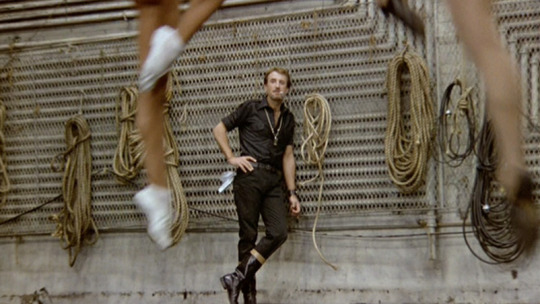Dancing in the Movies: Tail-feathers Shaken from “Singing in the Rain” to “Dogtooth” by David Dastmalchian
By Yasmina Tawil

From the first moment I saw Gene Kelly’s dress shoes splashing through the puddles on that marvelous cutout MGM set to the skintight cat suit gyrations of Olivia Newton John’s hips while she belted “You’re the One That I Want,” I have personally been a fetishistic slave to the power of bodies in motion on film. When I was a kid, I was captivated by the way that Gene Wilder rolled from geriatric frailty into his true Wonka wonder during his inimitable introduction and would often attempt to recreate the song-and-dance routine that Wilder brought to life with Peter Boyle in Mel Brooks’s masterful Young Frankenstein. Was it simply the magical music and undeniable rhythms these movies presented that made me want to move? Or is there something more that makes bodies in motion on celluloid (or digital, though I’m trying to think of any films in recent memory with memorable dancing which were shot digitally) so provoking and communicative? I think I’ve figured it out.
Before I lay out my big answer, though, I want to just indulge a bit here and talk about the things that have made my experiences watching dance in movies so captivating. Mind you, when I say, “dance” I mean quite literally ANY way in which actors have been choreographed or directed to allow their bodies to just – well, get weird. Dancing is kind of weird and when bodies start to get weird, wonderful things can happen. Remember what happened to your brain the first time bodies started shaking at Babs’s birthday party in Pink Flamingos (or MOST of Hairspray?!)? Or the way your mind melted when Magenta started Time Warping?

In one of the most impressive feats of physical limit-pushing, the entire experience of Bob Fosse’s All That Jazz works on such a gut-twisting primal level because Joe Gideon’s (Roy Scheider) Inferno-like descent is marked and whipped by the frenetic and exhausting physical demands of motion he – and every other character around him – experiences. It’s one of my friend Jimmy McDermott’s favorite films and I think its effectiveness derives from Fosse’s ability to hook us through the eyelids as every body in crisis collapses throughout the shooting.
Along those lines, I remember sitting in a theater in extreme discomfort (that’s a good thing) while Older and Younger Daughter danced relentlessly to their brother’s guitar strumming in Dogtooth. (Here’s my chance to plug Arturo Ripstein’s stronger Castle of Purity from which Dogtooth borrowed, well, almost everything but the dancing.) Or sitting at the Oak Park Plaza theater alone in sixth grade watching Ted Levine’s bizarre and sad self-serenade in Silence of the Lambs. Linnea Quigley’s graveyard seduction in Return of the Living Dead, Liz Taylor’s way-out wiggling in Who’s Afraid of Virginia Woolf?, Miranda July’s bizarre modern dance sequences in The Future… The list goes on…
Since the subject has been “dancing” around my head lately (Yeah, I did that.), I’ve concluded that my two favorite cinematic dance moments are probably the best ever captured by a camera. They’re both classics. First and foremost is the brutal, unforgiving and gorgeous way that Moira Shearer is whipped up and across the screen to near-death exhaustion by the devil himself in Powell/Pressburger’s The Red Shoes. That “Dance of the Red Shoes" sequence takes it all out of me. My number one comes from – you guessed it – Singin’ in the Rain. It’s not the namesake scene or “Gotta Dance” even. The only scene that wrecks me more solidly and leaves my jaw on the floor every time I behold it is the inhuman way that Donald O’Connor abuses his body in the most acrobatic and hilarious style in “Make ‘Em Laugh.”
O’Connor’s character, Cosmo Brown, is the funny bone of the picture but the scene actually conveys something deeper. His desperation to appease an audience has made him a physical slave to a point of self-destruction – all while staying in tune and keeping a smile on his face. When a filmmaker conveys the deep and extreme emotions in an actor without dialogue, something compelling happens to us – both visually and narratively that has a wholly unique and powerful effect on the audience. That’s what I’m talking about.
There’s just this incredible thing that can be expressed by a camera focused (or out of focused) on a body in motion. The way it’s lit, the movement of the camera, and the bodies in or out of sync, dancing together as the story comes to life – even the best writing can’t explain in parenthetical descriptives.
The hips, baby. It’s all in the hips. As Bob Fosse said, “Choreography is just writing on your feet.”


